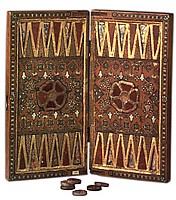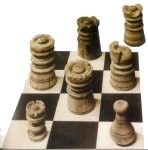|

Medieval
Board Games
TRIC TRAC - CHESS - MERRILS

Three of the
most popular board games during the Middle Ages were chess, tric-trac,
which we now call backgammon, and Merrils or Nine Man's Morris.
Playing boards could be simple but most of those which have survived
today show elaborate inlaid panels or painted boards and pieces
which were skillfully carved. Merrils or Nine Man's Morris was
also played but these do not seem to have been afforded the same
level of workmanship with either boards or playing pieces.

Tric
Trac
Tric-Trac, or backgammon has been played for hundreds of years,
as was a game enjoyed by medieval upper classes. Unlike cards,
this was a game which could be played by ladies, and we see this
in contemporary illuminations.
Shown at right, is a painted and inlaid tric-trac board with gold
gilding and rose-and-lily central design. The board itself is
hinged but does not have a designated area for bearing off at
the end of the game.
Each player starts with a certain number of pieces set out on
the board, and the aim of the game is to get all of your own pieces
home while hindering your opponant's pieces as much as possible.
Two dice determine the number of moves which may be made at any
given time.

Chess
 Modern
chess has its history in the far east, but made its way to the
European world during the middle ages. Chess was a game which
was also popular with female nobility and women in the upper classes. Modern
chess has its history in the far east, but made its way to the
European world during the middle ages. Chess was a game which
was also popular with female nobility and women in the upper classes.
The pieces were carved out of materials which ranged from simple
wood to bone and ivory. Naturally, ivory chess sets were exclusively
the domain of the wealthy.
Shown, at right, is a common bone chess set from the 14th century
from Scandinavia. It is housed in the Musée National
du Moyen-Âge, in Cluny, France. More famous are the
Lewis Chessmen, housed in the British Museum which feature beautifully
carved pieces of figures.
The set up and starting positions
and rules for medieval chess were mostly similar to those which
we have today, with only a few variations.
 The
pieces moved as follows: The
pieces moved as follows:
- The king moved as
normal.
- The rook moved as normal.
- The knight moved as normal.
- The pawns only traveled one square, even on the first move.
- The bishops moved diagonally only two squares but could jump
other pieces.
- The queen moved diagonally only, and one square at a time.
- Stalemate and Checkmate were the same as today.
- Baremate also existed if a king was left with no pieces.

Merrills
 Merrils
was another popular medieval board game. Sometimes called Nine
Man's Morris, it was played on an board with markers, and the
aim of the game was to capture all the opponant's pieces. Merrils
was another popular medieval board game. Sometimes called Nine
Man's Morris, it was played on an board with markers, and the
aim of the game was to capture all the opponant's pieces.
Unlike other board games, Merrills starts with an empty board
and pieces ar eadded to it, unlike chess or tric-trac where the
game is started with pieces on the board.
The image at the right from the Romance of Alexander, shows
a Lady and a gantleman playing at Merrils.
There are a few variations of the game, and the instructions and
rules are found HERE.

Copyright
© Rosalie Gilbert
All text & photographs within this site are the property of
Rosalie Gilbert unless stated.
Art & artifact images remain the property of the owner.
Images and text may not be copied and used without permission.
|